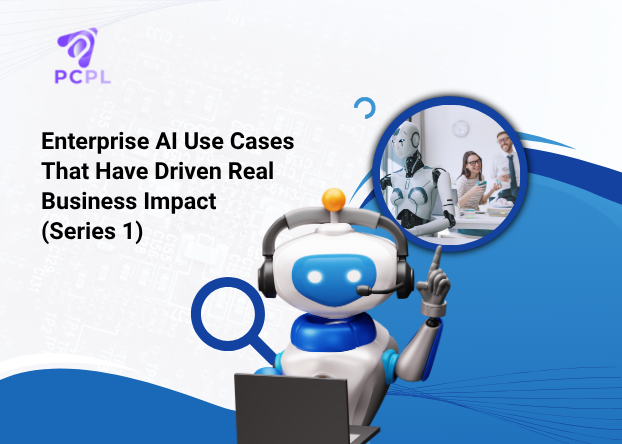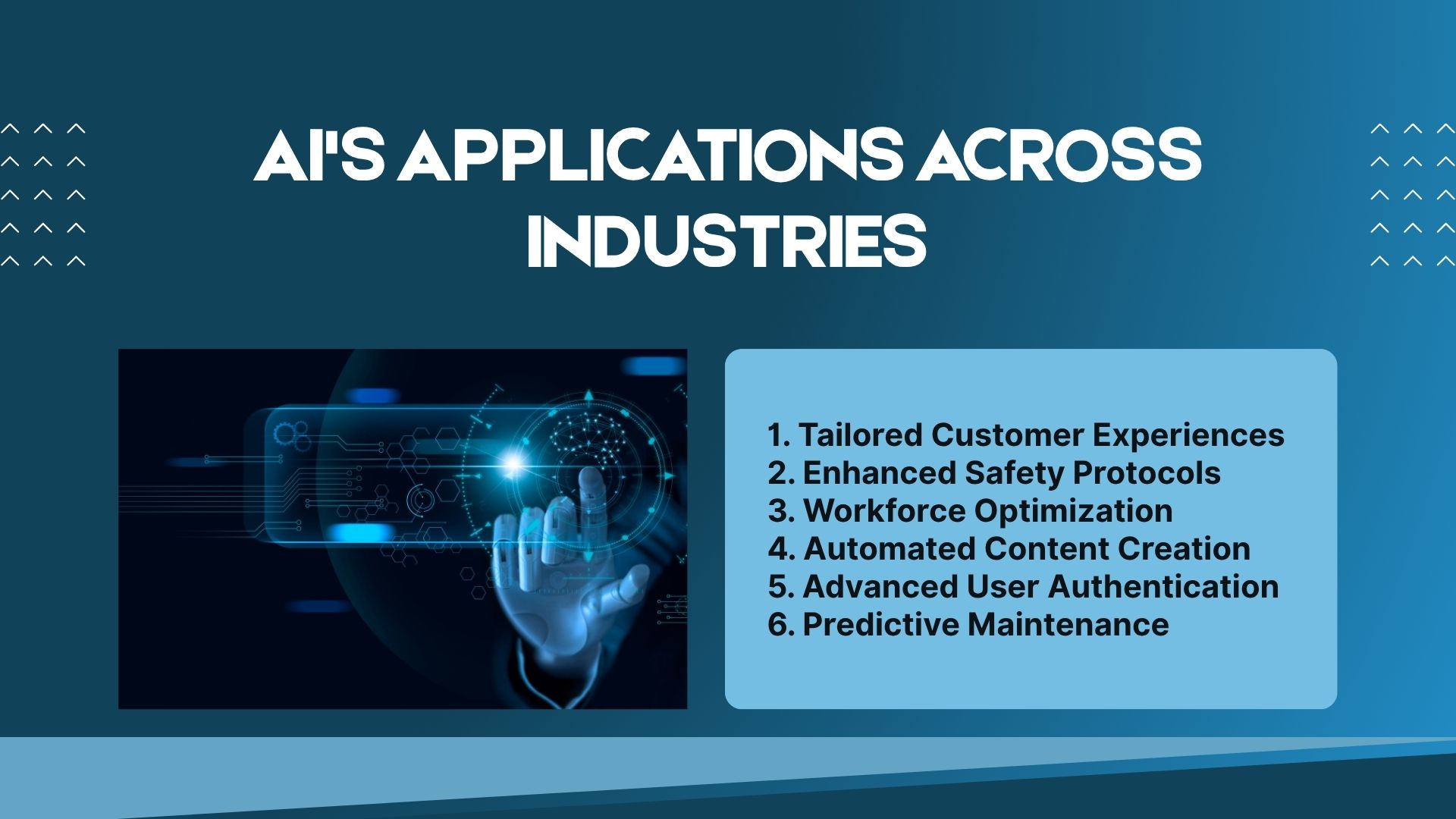
Enterprise AI Use Cases That Have Driven Real Business Impact (Series 1)
Artificial intelligence has seamlessly integrated into our daily discourse, much like discussing everyday topics such as the weather or recent sporting events. It’s no longer an exclusive topic for tech experts. However, for numerous businesses, the successful integration of AI still presents a considerable challenge.
Determining the genuine value of AI tools demands a thorough assessment, or at least it should. Decision-makers must weigh the immediate advantages and expenses against the potential for future gains. They need to meticulously evaluate specific applications before concluding that the latest advancements are suitable for their needs.
Regardless of the strategy, many sectors are already seeing substantial advantages from adopting AI.
AI’s Applications Across Industries

- Tailored Customer Experiences
AI customizes interactions and recommendations based on individual customer preferences and past behaviors. This approach is important for businesses aiming to boost customer satisfaction and foster loyalty. It’s also a prevalent strategy for marketing teams and product managers utilizing AI tools.
AI crafts a seamless and highly individualized experience for each customer by analyzing data from various touchpoints like purchase history, Browse patterns, and social media activity.
AI recommends products based on customer preferences and behavior. It personalizes marketing campaigns and product suggestions for individual users. It enhances guest experiences through customized service offerings and tailors content recommendations for streaming services. Al also helps develop personalized treatment plans based on patient data.
Examples-
- Sephora implemented AI with its Virtual Artist tool, enabling customers to virtually try on makeup and receive personalized beauty advice. This tool has significantly increased customer engagement and sales, as consumers are more inclined to buy products aligned with their preferences.
- Amazon utilizes AI to recommend products to users based on their Browse and purchase history, along with items in their cart. This has substantially boosted cross-selling and upselling opportunities, contributing to Amazon’s remarkable sales growth.
- Netflix employs AI algorithms to give suggestions about shows and movies to users based on their viewing history and preferences. This personalized content keeps users engaged with the platform and helps reduce churn.
- Enhanced Safety Protocols
AI strengthens safety measures by monitoring as well as analyzing data in real time. Employing AI in this context helps identify potential hazards and ensures adherence to safety regulations.
AI-powered safety systems combine sensors, cameras, and data analytics to monitor environments. They are highly effective at detecting anomalies that could pose threats. These systems can process vast amounts of data from multiple sources simultaneously, enabling rapid identification of issues that human observers might miss.
We find AI-driven safety features in vehicles. AI helps monitor machinery and workplace conditions to prevent accidents. It also provides real-time hazard detection and safety compliance monitoring as well as monitors aircraft systems for safety and performance. It also boosts the security of residential properties with smart devices.
Success Stories-
- Tesla integrates AI into its Autopilot system to enhance vehicle safety by continuously monitoring road conditions and driver behavior. This proactive safety feature has contributed to a reduction in accidents. Tesla’s AI system can intervene to prevent potential collisions, making driving safer for everyone.
- Boeing makes use of AI to detect anomalies in aircraft sensors and analyze flight data. This predictive maintenance strategy has enhanced flight safety by identifying potential issues before they escalate. Boeing’s use of AI makes sure that aircrafts consistently operate at optimal safety levels.
- Nest (Google) has incorporated AI into its home safety products, including smoke detectors and intrusion detection systems. The AI algorithms help differentiate between genuine emergencies and false alarms, ensuring appropriate actions are taken only when necessary. This smart home technology not only enhances home security but also offers homeowners peace of mind.
- Workforce Optimization
AI simplifies work schedule management for businesses. It can forecast employee needs based on historical data, peak seasons, and current activities, preventing overstaffing or understaffing. This data-driven method helps save costs and maintains order during busy periods.
AI also considers employee preferences, availability, and skills when creating schedules. This leads to shifts that better suit employees’ lives. Additionally, managers spend less time on scheduling, allowing them to focus on more critical tasks.
AI enables efficient staff scheduling and management, predicts staffing needs based on patient influx, optimizes workforce deployment during peak hours, streamlines staff allocation in warehouses, and ensures optimal labor distribution based on production demands.
Examples-
- Hilton Hotels used AI to streamline the scheduling of employee, leading to improved staff satisfaction and operational efficiency. A more content and engaged staff, in turn, resulted in enhanced guest experiences.
- DHL has implemented AI to predict workloads and optimize staff deployment in their warehouses. This has led to improved efficiency and reduced operational costs.
- Automated Content Creation
AI assists in content generation by analyzing trends, developing narratives, and automating repetitive tasks. This ensures a consistent flow of high-quality content tailored to audience preferences.
Enterprise AI tools can quickly identify popular and trending topics, informing businesses about the type of content that will capture attention. AI can give suggestions for headlines, draft articles, and even automate the creation of social media posts. This significantly reduces time spent on repetitive writing tasks, allowing human creators to focus on broader strategies and long-term goals.
For example, AI can analyze successful articles to determine what makes them resonate, whether it’s the topic, writing style, or visuals. Then, AI can help produce similar content with a high likelihood of success.
AI helps generate automated news reports and articles, personalized and data-driven content generation, create product descriptions and marketing materials, develop customized learning materials and assessments and generate engaging and targeted content for audiences.
Success Stories-
- The Washington Post uses AI through its Heliograf tool to generate short news reports and updates, significantly increasing their content output without sacrificing quality.
- Associated Press (AP) has used AI to automate the creation of earnings reports and other routine stories, enabling journalists to concentrate on more complex investigative reporting.
- BuzzFeed makes use of AI to analyze reader data and craft viral headlines, optimizing content for maximum engagement.
- Advanced User Authentication
AI enhances security through sophisticated user authentication methods such as biometric verification, behavioral analysis, and multi-factor authentication. This helps reduce fraud and ensures secure system access.
AI-powered security utilizes intelligent technology to protect information. For example, biometric verification includes fingerprint or face scans. Multi-factor authentication (MFA) needs more than just a password. It might involve a code sent to your phone or a fingerprint scan. AI systems can alert administrators or users to suspicious login activities or other potentially malicious behavior.
Behavioral analysis examines typical user actions, such as typing patterns or mouse movements. If unusual activity occurs, the system can detect it and request additional verification. These methods help identify fraudsters and ensure only authorized individuals gain access.
Examples-
- Mastercard implemented AI-powered biometric cards, improving security and user convenience by using fingerprint authentication instead of traditional PINs.
- Apple uses AI in its Face ID technology, providing secure and seamless user authentication for iPhone users.
- HSBC has integrated AI-based voice recognition for secure customer authentication over the phone, reducing fraud and enhancing customer experience.
AI helps secure customer authentication for transactions, fraud detection and secure online payments, strengthens security protocols for software access, ensures secure access to patient data and medical records, and provides secure authentication for customer service.
- Predictive Maintenance
Imagine AI as a smart mechanic who anticipates when a machine might have a problem. It analyzes data from machine sensors, such as temperature and vibrations, and compares it to historical data. If something seems off, the AI warns that a part may soon require repair.
This concept extends to the IT industry. If a server becomes unusually slow or if there’s an unusual spike in network activity, AI alerts the IT team to a potential issue. This allows them to address the problem early, perhaps by upgrading hardware or enhancing security, before it leads to a system crash or data breach. This proactive maintenance ensures websites and applications run smoothly, data remains secure, and costly downtime is avoided.
Success Stories-
- Siemens uses AI for predictive maintenance in their industrial machines, significantly reducing unexpected failures and maintenance costs.
- General Electric (GE) employs AI to monitor its jet engines, predicting maintenance needs before issues arise, thereby enhancing reliability and safety.
- Shell has implemented AI for predictive maintenance in its oil and gas operations, leading to reduced downtime and improved operational efficiency.
AI prevents equipment breakdowns and optimizes maintenance schedules, monitors system performance and preempts potential issues to ensure smooth operation, ensures vehicle reliability and safety, monitors and maintains important infrastructure, enhances the reliability and safety of aircraft, and enhances the maintenance of power grids and water systems.
There are so many sectors that AI has impressed its value upon that it is difficult to pen it down in a single blog and so you will have to stay tuned for the next blog to know about more of the use cases.
References
https://www.moveworks.com/us/en/resources/blog/enterprise-ai-use-cases-real-world-examples
https://productschool.com/blog/artificial-intelligence/ai-business-use-cases
https://www.ibm.com/think/topics/artificial-intelligence-business-use-cases
